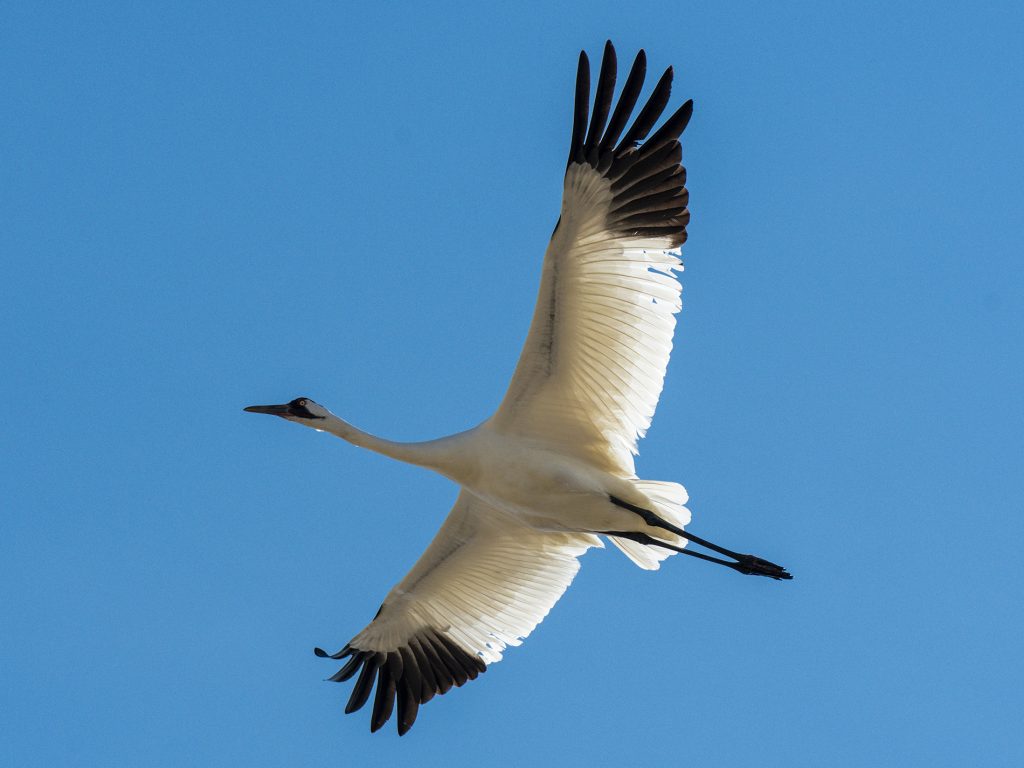Sandhill Cranes
Experience the phenomenal Sandhill Crane migration each spring in central Nebraska. Over 80% of the world’s Sandhill Cranes stopover on the central Platte River Valley, with peak numbers occurring between early March and early April. However, they can be viewed earlier, as some remain in Nebraska throughout winter, delaying or even forgoing fall migration to southern wintering grounds. Additionally, crane migration has been shifting earlier and earlier each year.
The central Platte region contains important habitats for the Sandhill Cranes including sandbars in the shallow braided Platte River which are safe roost sites for the cranes, keeping them protected from nighttime predators. During the day, the cranes forage in adjacent crop fields and wet meadows to build up enough energy for their long journey north to their breeding grounds. Cranes are social birds and may be seen dancing to strengthen pair bonds. It is hard not to be awe-struck by the shear number, size, and loud distinctive calls that fill the air while observing the cranes in Nebraska.
Where to view
The best viewing of the cranes occurs along the central Platte River. There are several different ways to enjoy this spectacular crane migration, from free self-guided driving tours, to fee-based guided tours or viewing blinds, to watching the cranes from live cams in the comfort of your own home.
Crane Trust Nature & Visitor Center, Wood River, NE
- Guided tours and viewing blinds, reservations required at (308) 382-1820. Learn more.
Iain Nicolson Audubon Center at Rowe Sanctuary, Gibbon, NE
- Guided tours and viewing blinds, reservations required at (308) 468-5282. Learn more.
North Platte public crane blinds, North Platte & Hershey, NE
- There are some free, first come, first serve crane blinds available beginning in early March around the North Platte area. Learn more.
Self-Guided Driving Tours
- Drive yourself through central Nebraska to view these magnificent birds.
Find a route for you.
Live Cams
- Audubon’s Rowe Sanctuary
Crane camera - Platte Basin Timelapse at Rowe Sanctuary
Crane camera
Viewing tips & etiquette
- The best viewing of Sandhill cranes can begin as early as February and into late April, with recent observations indicating some cranes are beginning their migration earlier. Be aware that weather can influence migration timing. It is a good idea to contact local crane experts ahead of your visit.
- If you are making a trip to see cranes in Nebraska, an excursion to a viewing blind or platform in the early morning, evening, or both, is strongly recommended.
- During the day drive the county roads to see the cranes feed, dance and rest in ag fields.
- Use designated viewing sites to watch the cranes, respecting private property. Most land in the Platte River valley is private.
- To prevent disturbance to the cranes, use your vehicle as a ‘blind’ and stay in your car or right next to it.
- Be respectful to the cranes and other visitors, by staying quiet and not approaching the cranes at any time.
- Weather conditions can change rapidly on the great plains during late winter and early spring. Plan accordingly by dressing in warm layers suitable for low temperatures.
- For more information about the Sandhill Crane migration, click here.
Whooping cranes
Occasionally, an endangered Whooping Crane is observed foraging among a flock of Sandhill Cranes. Whooping Cranes stand out with their bright white plumage, larger size, and red crown and mustache. In flight, they have black wing tips that contrast with their white plumage. If you see a Whooping Crane please report the sighting here.


